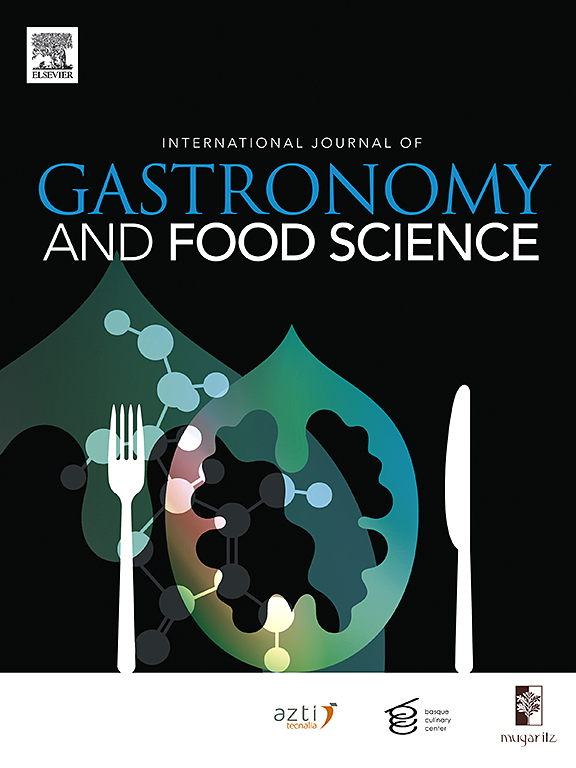含或不含螺旋藻的腰果素食沙拉酱:物理化学、流变学和感官表征以及酚类化合物的体外消化
IF 3.2
2区 农林科学
Q2 FOOD SCIENCE & TECHNOLOGY
International Journal of Gastronomy and Food Science
Pub Date : 2025-05-10
DOI:10.1016/j.ijgfs.2025.101199
引用次数: 0
摘要
对植物性食品日益增长的需求推动了创新素食产品的发展。在这种情况下,腰果代表了一种极好的植物基酱料基质,而螺旋藻由于其酚类化合物而成为一种有前途的成分。本研究旨在开发以腰果为原料,以螺旋藻为功能成分的创新型素食沙拉酱。通过结合这些成分,该配方提供了一种新颖的植物性替代品,符合对营养丰富、无动物来源成分的清洁标签产品日益增长的需求。配制了3种配方,分别为不含红木的F1(对照)和添加1%和2%红木生物量的F2和F3。配方受到近似组成,微生物和感官分析。在冷藏期间,对配方的理化特性、颜色、流变特性和质地、体外消化、抗氧化活性和酚类化合物的生物可及性进行了评估。这些沙拉酱配方的平均脂肪含量(8.84%)和蛋白质含量(4.86%)相似,可以认为脂肪含量降低了。F1的碳水化合物含量最高(13.07%),F3的灰分含量最高(2.29%)。添加白刺生物量后,贮藏过程中白刺的光亮度下降,呈绿色,但其流变特性和结构特征保持不变。基于体外消化,F3作为酚类化合物的来源,在肠期表现出更高的浓度(0.85 g没食子酸当量g−1)。酚类化合物的生物可及性随着杉木生物量的增加而增加。对于感官评估,大多数小组成员表示对食用含有微藻的食物感兴趣。白檀对沙拉酱的整体接受度、颜色和香气没有显著影响,沙拉酱配方的感官接受度得分较高。F1和F2的味道被小组成员所接受。综上所述,以腰果为原料的沙拉酱,无论是否添加腰果,都是一种很有前景的选择,可以满足人们对具有差异化成分和感官特征的新型素食食品的需求。本文章由计算机程序翻译,如有差异,请以英文原文为准。
Vegan salad dressing based on cashew nuts with or without Spirulina platensis: Physicochemical, rheological, and sensory characterization and in vitro digestion of phenolic compounds
The growing demand for plant-based foods has driven the development of innovative vegan products. In this context, cashew nuts represent an excellent plant-based matrix for sauces, while Spirulina platensis emerges as a promising ingredient due to its phenolic compounds. This study aimed to develop innovative vegan salad dressings based on cashew nuts, incorporating Spirulina platensis as a functional ingredient. By combining these components, the formulation offers a novel plant-based alternative that aligns with the growing demand for nutritious, clean-label products free from animal-derived ingredients. Three formulations were developed: F1 without S. platensis (control), and F2 and F3 with 1 % and 2 % S. platensis biomass, respectively. The formulations were subjected to proximate composition, microbiological, and sensory analyses. During refrigerated storage, the formulations were evaluated for physicochemical characteristics, color, rheological properties and texture, in vitro digestion, antioxidant activity, and the bioaccessibility of phenolic compounds. The salad dressing formulations presented a similar average lipid (8.84 %) and protein (4.86 %) contents, and can be considered to have a reduced lipid content. F1 had the highest carbohydrate content (13.07 %), and F3 had the highest ash content (2.29 %). When adding S. platensis biomass, the brightness decreased and there was a tendency to develop a green color during storage, while the rheological behavior and textural profile remained the same. Based on in vitro digestion, F3 stood out as a source of phenolic compounds, presenting a higher concentration in the intestinal phase (0.85 g gallic acid equivalents g−1). The bioaccessibility of phenolic compounds increased as the S. platensis biomass increased. For the sensory evaluation, most of the panelists expressed interest in consuming foods containing microalgae. S. platensis had no significant influence on the overall acceptance, color, and aroma, and the salad dressing formulations received high sensory acceptance scores. The flavor of F1 and F2 was the well accepted by the panelists. In conclusion, salad dressing based on cashew nuts, with or without S. platensis, is a promising option that satisfies the demand for new vegan foods with differentiated composition and sensory characteristics.
求助全文
通过发布文献求助,成功后即可免费获取论文全文。
去求助
来源期刊

International Journal of Gastronomy and Food Science
Social Sciences-Cultural Studies
CiteScore
5.30
自引率
10.50%
发文量
170
审稿时长
45 days
期刊介绍:
International Journal of Gastronomy and Food Science is a peer-reviewed journal that explicitly focuses on the interface of food science and gastronomy. Articles focusing only on food science will not be considered. This journal equally encourages both scientists and chefs to publish original scientific papers, review articles and original culinary works. We seek articles with clear evidence of this interaction. From a scientific perspective, this publication aims to become the home for research from the whole community of food science and gastronomy.
IJGFS explores all aspects related to the growing field of the interaction of gastronomy and food science, in areas such as food chemistry, food technology and culinary techniques, food microbiology, genetics, sensory science, neuroscience, psychology, culinary concepts, culinary trends, and gastronomic experience (all the elements that contribute to the appreciation and enjoyment of the meal. Also relevant is research on science-based educational programs in gastronomy, anthropology, gastronomic history and food sociology. All these areas of knowledge are crucial to gastronomy, as they contribute to a better understanding of this broad term and its practical implications for science and society.
 求助内容:
求助内容: 应助结果提醒方式:
应助结果提醒方式:


